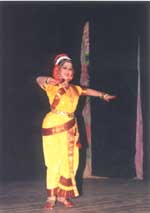Riches In Ruins

Riches In Ruins is an event that took place on 26-Dec-2000 in Hyderabad.
-
Venue
-
Date/Time
-
Type
-
Price
-
Add New Field:
REVIEW FOR RICHES IN RUINS
Kuchipudi dancers galore! Alekhya to Rama Devi, Sethuram, Saritha Dilip, Swathy Somanath and more, the three day Kuchipudi solo dance festival will feature dancers at this withered venue for 3 days. A bit about the venue first: this theater needs badly renovation, for its roof leaks when it rains, the shrunken chairs give you a backache and the smeared walls of the green rooms make the performers restless - and there is more that we are ignoring. Yet, this venue becomes a platform for many festivals, felicitation functions and musical nites!
The reason could be its low rentals, its large local audience to fill in the hall and, above all, the fact that Hyderabadi dancers and musicians are not choosy about a venue or the audience, and cannot say no to an offer! What seems to matter is going on and on, churning out performances!
Anyway, the present festival, organized by Sri Vaishnavi Kuchipudi Nritya Kala Niketan, saw Alekhya commence with the traditional Tarangam of Narayana Theertha. The dancer traced the image of the auspicious symbol of the Hindu pantheon. This very first Tarangam, "Jaya Jaya Swamin Jaya Jaya", attributed to Ganesha by the poet, was vibrantly choreographed, while a contemporary Varnam of Balamurali Krishna, "Om Kaara Pranava Nado Oo", illustrated, in a wholesome manner, the divine symbol Om, and its pervasive presence in the five elements. In this, the dancer, balancing the rhythmic pace, rendered the spirit and substance of earth and space.
A Javali by the same poet with the soft dance of a heroine in love provided a brief interlude, before the dancer went on to perform yet another ornate number. This piece of Annamacharya, "Parama Purushudu", set to Mohana raga, described the Vaishnava God and his omniscient aura. He is at once a child for Yashoda, and the one who protects the whole of mankind and also the one who preaches the Geeta. Alekhya's recital was backed by Raghunandan's nattuvangam, Vinod's percussion and Sweta and Lavanya's vocal support.
Later in the evening, Rama Devi staged her solo recital. Here the dancer chose to commence with a rare piece, illustrating the evolution of the 'Ganesha' form with an elephant head, with a brief drama backed by the poetry of M N Murthy. Yet another story of birth and growth comes in this Thyagaraja composition, "Sri Raghukulamandu" (the birth of Rama and his brothers, after the Putrakameshti Yagnam and so on). Rama too chose to break the monotony with a Srungara Javali, before concluding with a Tarangam, "Madhava Mamava Deva".
The musical support comprised of Renuka's nattuvangam, Srivalli Sarma's song and Sridharachari's percussion. Both the artistes were felicitated in the evening.
USER REVIEWS FOR RICHES IN RUINS
Be the first to comment on Riches In Ruins! Just use the simple form below.
LEAVE A COMMENT
fullhyd.com has 700,000+ monthly visits. Tell Hyderabad what you feel about Riches In Ruins!
MORE EVENTS IN THIS PERIOD
ALL EVENT CATEGORIES
SEARCH EVENTS
Dissatisfied with the results? Report a problem or error, or add a listing.
ADVERTISEMENT
SHOUTBOX!
{{ todo.summary }}... expand »
{{ todo.text }}
« collapse
First | Prev |
1 2 3
{{current_page-1}} {{current_page}} {{current_page+1}}
{{last_page-2}} {{last_page-1}} {{last_page}}
| Next | Last
{{todos[0].name}}
{{todos[0].text}}
ADVERTISEMENT
This page was tagged for
Sri Thyagaraja Gana Sabha events
December 2000 events
hyderabad arts
hyderabad theatre / comedy / dance
hyderabad festivals / fairs